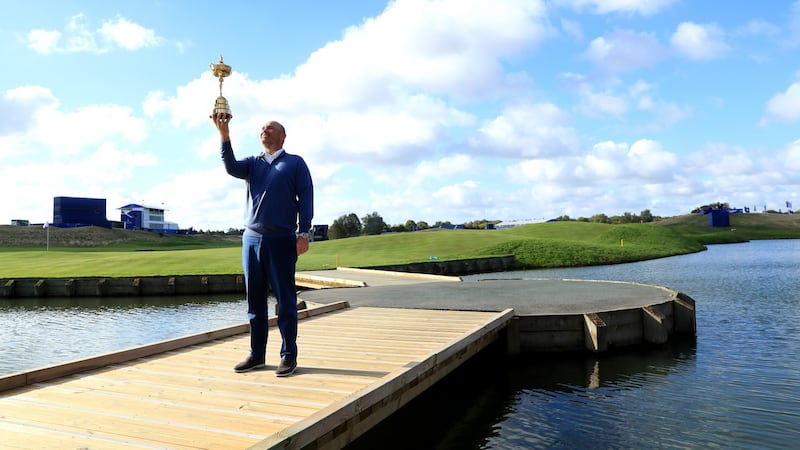Thomas Bjorn – just as Paul McGinley was – will be a hard act to follow, the toughest part being that the next Ryder Cup will be fought on a battlefield in the United States on their terms. But someone from within the inner sanctum has to be the leader of men for the next task and the odds, it would seem, are stacked in favour of Pádraig Harrington being that captain.
You don't officially throw your hat into the ring in these things. But the whispers and the words all add up, and the 47-year-old Dubliner – a three-time Major winner, a six-timer Ryder Cupper on four winning teams and, perhaps most pertinently in this context, a three-time vice-captain – has emerged as the firm favourite to fulfill the role at Whistling Straits, Wisconsin, in 2020.
A decision on the captain to succeed Bjorn – who did a terrific job, keeping the focus on the 12 players – is expected to be made in the coming months, with the likely man in situ before Christmas. The process for selecting the captain features a committee comprised of the three immediate past captains (Bjorn, Darren Clarke and McGinley), along with Keith Pelley, the chief executive of the European Tour, and one member of the tournament committee.
The successful European template of recent decades (which has resulted in seven wins from the last nine) has been to promote from within, as it were: Torrance. Langer. Woosie. Faldo. Monty. Olazabal. McGinley. Clarke. Bjorn. Those charged with captaincy have done the spadework, served their time, and Harrington ticks the boxes in all departments.
But the challenge for anyone inclined to accept the task in two years time – as Faldo (in 2008) and Clarke (in 2016) discovered – is in taking on a wounded USA team on home turf. That, perhaps, is the only area which brings any “trepidation,” as Harrington himself put it, to the role. “You don’t want to be a losing captain, you get thrown under the bus if you are,” he said.
One thing is clear, though: Harrington would like to be a captain. “I’d love to bring my thoughts to the game. It’s an interesting one, because I wouldn’t do it without a certain amount of trepidation because it’s not easy. It’s a tough job. Unfortunately the captains get judged on results rather than anything else. I wouldn’t go into it lightly, but on balance, yes I want to be a Ryder Cup captain,” he confirmed.

This latest vice-captaincy saw him still picking up ideas. “You definitely pick stuff up. I wrote notes down again this week. You are always learning, and it was a nice balanced vice-captaincy with different personalities in there. Having done the others, I knew the pivotal times when the pressure was on the captain. There are a couple of hours, Friday morning and evening and Saturday morning and evening when teams have to go in, and we have to get that team ready and present it and get Thomas looking at it and thinking about it. It was a good balance among the vice-captains, some good emotions and some good thinkers. I thought it worked out very well,” said Harrington.
The next Ryder Cup will be on familiar ground for most of the likely Europeans, as Whistling Straits has staged two US PGAs – in 2010 (won by Martin Kaymer) and 2015 (won by Jason Day) – and, of all US venues, it is one which Harrington believes will suit a visiting team. He explained: “If Europe was to pick a course in the States, we’d pick Whistling Straits. It’s a windy links golf course, and it could be quite cold at that time of year. It is not like they can get the greens super quick that week. They will work to play to their strengths but it is a course, due to the nature of it, that has some European qualities. It’s a good track for Europe. It’s a good one for Europe to go to. It’s as European as it gets (in the United States).
“Whoever is next, there will be a good bit of this team still there. There are also some nice players who missed out this time. Somebody like Matt Wallace is a player for the future coming strong. At a US golf course, you’re looking at players like Thomas Pieters who make birdies. Maybe a different style of player is needed. It’s not necessarily the 12 best players, you need the 12 best for a team,” added Harrington.
Bjorn’s relationship with Harrington goes back to their first year as professionals in 1997 when the Dane edged the Irishman for ‘rookie of the year’ honours on the European Tour, a long time of soldiering beside each other on tour and in Ryder Cup team rooms.
Of Harrington, Bjorn said: “Oh, he’d be brilliant. He’s got all the tools and all the knowledge,” adding that all the vice-captains at Le Golf National “will all be quality, if they do it or when they do it.”
Graeme McDowell, another of those vice-captains in Paris, said of Harrington: “He sees all the angles. He’s calculating. He has that analytical brain that dots all the ‘i’s and crosses all the ‘t’s. I’d love to help him out.”
As Rory McIlroy, too, put it, there is a “continuity” in the European camp – from player to vice-captain to captain – that has served them well. Why change a winning formula?


















